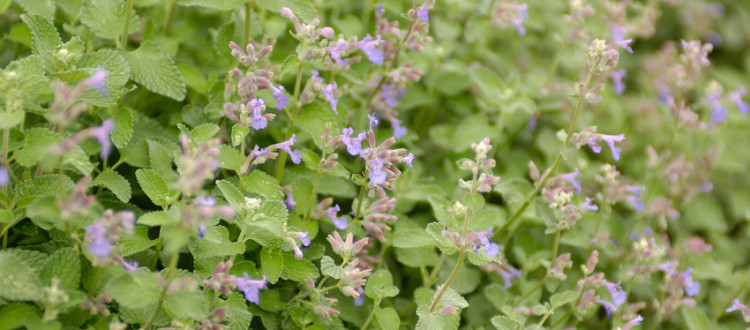Catnip
Catnip (Nepeta cataria) is a perennial ornamental plant also known as catmint or catswort, and is generally believed to have earned its common name due to the strong level of attraction many cats have to it. A member of the mint (Lamiaceae) family, catnip can grow to between 20 and 48 inches tall and just as wide with triangular leaves that are light green with lavender colored flowers on spikes that can reach up to five inches in length.
Catnip contains nepetelactone, an oil that is believed to produce an hallucinogenic effect on cats. The oil is contained in the leaves and stems. Cats can detect nepetelactone in the air in as small a concentration as one part per billion, and will eat the leaves in order to induce the oil’s effect. Nepetelactone is also effective at repelling mosquitos, and is also believed to be effective at warding off rats and mice as well as garden pests such as squash bugs and aphids. It is drought tolerant and deer resistant. Butterflies are attracted to it as well.
How to Plant
Plant catnip after the danger of frost has passed in soil that drains well and in full sun, spaced between 14 and 18 inches apart. Since catnip is a member of the mint family, it can reach up to five feet in height. Allow the soil to dry between waterings to avoid over-watering, but keep watering it, especially just after planting. Note: your cat will want to love the plant, perhaps before the plant is strong enough. Be aware and keep the kitties away.
Since cats enjoy rolling around in catnip, it should be planted in its own area to avoid damaging the rest of the garden. If your cat is an indoor kitty, catnip does well in pots. It is recommended that you plant several pots in order to continually rotate them from inside to outdoors, not only for the plant’s general health but also to prevent your cat from loving the plant to death.
A word of caution: catnip has a distinctive fragrance that some find off-putting. Give some thought about where to plant it in your garden.
Fertilizing
Catnip should be fertilized at regular intervals throughout the growing season with a balanced fertilizer.
Harvesting
Catnip leaves can be harvested by pinching the top leaves off. This helps prevent the plant from becoming leggy and encourages a bushier, more compact structure. Flowers will begin to form mid-season and once they die back, small buds with seeds in them will form. The buds can and should be harvested to prevent the proliferation of “volunteer” catnip plants. The buds contain a greater concentration of nepetelactone than the leaves and stems, and will be extra appealing (and stimulating) to your cat. The buds can be dried in an over at low heat for storage through the winter.
Recommendations for Use
- Besides growing catnip to keep your kitties entertained, catnip is often used to make an herbal tea that is used for its mild relaxation qualities. It has a minty taste to it, but also has a pungency that might have you considering adding honey to it. To prepare, bring water to the boil and remove from the heat before adding catnip leaves, either freshly picked or air dried, for 10 to 20 minutes.
- Catnip’s calming effects are often compared to valerian root, and is used for a number of physical maladies in folk medicine, including relief from toothaches and for settling an upset tummy.

